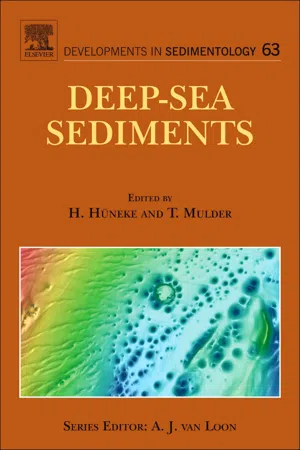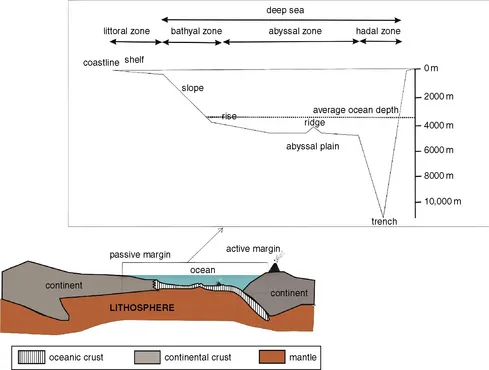Thierry Mulder*, Heiko Hüneke†, A.J. Van Loon‡
* Université de Bordeaux, UMR CNRS 5805 EPOC, Avenue des Facultés, 33185 Talence Cedex, France
† Institut für Geographie und Geologie, Universität Greifswald, Jahn-Strasse 17a, D–17487 Greifswald
‡ Geological Institute, Adam Mickiewicz University, Maków Polnych 16, 61–606 Poznan, Poland
1 Introduction
In this book, all marine domains extending seaward of the shelf break are considered as deep-sea. This domain represents 63.6 % of the Earth’s surface (the ocean in its entirety covers 361×106 km2 or 70.8% of the Earth’s surface, including continental shelves). From a stricter geological point of view, the oceanic domain would begin at the boundary between the high-density (3.25 on average), usually thin (5 km in average) oceanic crust and the thick (30 km on average) low-density (2.7 in average) continental crust. A transitional crust may exist in between.
The study of deep-sea sediments benefited greatly from recent improvements in technologies. These improvements have been driven by academic needs (most of the sea floor remains unexplored in detail and most of the topography of abyssal plains has not been mapped with accurate tools) and by economic needs, such as the demand for mineral deposits (metal-bearing nodules, exploration of ultra-deep offshore oil). These newly-developed technologies benefited from both in situ data collection and data interpretation in laboratory.
In terms of data collection, this includes:
– Sea-floor morphology (multibeam bathymetry),
– subsurface investigation (seismic tools),
– high-resolution echosounders,
– 3-D tools,
– sampling gear (interface corer).
In terms of data interpretation in the laboratory, this includes:
– core scanners for measurement of geotechnical and physical properties, X-ray, geochemistry,
– the development of biological tracers and biomarkers for palaeoenvironmental reconstruction,
– the improvement and development of stratigraphic tools and dating methods based on radiogenic and non-radiogenic elements (especially for the Quaternary), the development of micro-lithostratigraphy (IRD, tephra recognition) and magnetostratigraphy.
1.1 Scope of the book
The chapters of this book have the following objectives:
– to explain the formation and supply of sedimentary particles by continental erosion (river load, ice or wind transport), coastal erosion, current-induced winnowing, through volcanic and authigenic processes, and by means of biogenic productivity;
– to describe the way the sediments are transported from the source area (continental edge, slope, surface water) to the accumulation zone in the deep-sea;
– to present the early geochemical transformations affecting the particles in the water column or the sediments as soon as they are produced and accumulate on the sea floor;
– to show how sediments are preserved on the sea floor despite erosion and dissolution;
– to present the characteristic features and main changes in worldwide ocean sedimentation with focus on “modern” oceans that have been formed since the disintegration of Pangaea (Mesozoic-Cenozoic);
– to discuss major changes in biogenic productivity, sea-water chemistry, and external controls of deep-sea sedimentary processes, depending on long-term trends in ocean history;
– to present the academic (e.g., palaeoclimatic studies), societal (e.g., natural hazards) and industrial interests (e.g., the exploration for mineral resources) in the study of deep-sea sediments.
2 What are Deep-Sea Sediments?
The sea-water environment can be subdivided into shallow (epicontinental) seas and deep seas. The morphology of modern oceans and marginal seas is based on the water depth and on changes in the slope gradient (Fig. 1.1). Using a classical cross-section through a passive continental margin, the shallowest environment is the continental shelf (or platform), which extends in the continental domain from the shoreline to the shelf break. It represents 26×106 km2 (7.2% of the marine area). In this area, the sea-floor gradient is < 0.5°. In offshore direction, the water depth extends down to 100–110 m such as on the north-western African margin (Seibold and Hinz, 1974) or 200 m on most of the continental margins, including the northern European and the North-American Atlantic margins. Its extent can be from several hundreds of kilometres (1500 km for the Siberian shelf, > 600 km for the southern Argentina–Patagonian Shelf) to a few kilometres (off Nice in the Mediterranean). Active continental margins, such as the South-American Pacific margin, are usually only a few kilometres wide.
The continental shelf is exposed to numerous oceanographic processes that are absent in deep seas. Most of them are related to atmospheric processes. They include swell and storm waves that generate oscillatory motions in the water column (producing specific sedimentary structures such as hummocky cross-stratifications), tides, shallow contour currents, as well as shelf and coastal currents, including littoral drift. The continental shelf is separated from the continental slope by the shelf break, which is defined by a change in the slope gradient. The slope steepens from a gradient < 1° on the shelf to 3–5° in average along the slope, to sometimes more than 20° in areas where canyons are incised the slope and the shelf. Further downslope, it passes into the continental rise at a water depth of about 2500 m. The continental slope corresponds approximately to the bathyal zone (200–3000 m). On the rise, the slope gradient decreases to 1–2° and the relief becomes smoother. Because of this change, the continental rise is the preferential area for final deposition of terrigenous sediment that bypassed the shelf and slope area. Together, the continental shelf, slope and rise form the continental margin. The margin can be passive and tectonically quiescent (North Atlantic margin) or active and tectonically dynamic (circum-Pacific margins).
At about 5000 m water depth, the rise passes into the abyssal plain. Abyssal plains represent the largest oceanic domains with a mean water depth of ~ 3800 m. Abyssal plains are “flat” at a large scale. A closer look reveals, however, that their “flatness” is disrupted by tectonic and volcanic features: transform faults at different scales and strike-like faults with hanging walls of several hundreds of metres or even several kilometres in height and related local sedimentary basins. There are, in addition, hot-spot-related volcanic mounds and islands, volcano alignments forming the oceanic ridges, channels and thick and extensive accumulations of sediments forming drifts, and levees, gypsum diapirs; there are also dissolution structures. The continental rise and abyssal plains constitute the abyssal domain (3000–6000 m). Only 2% of the total ocean surface is deeper than 6000 m (hadal domain). In subduction areas, the presence of a subduction trench generates the deepest oceanic environments, down to 11,020 m (Mariana Trench). There, the presence of an accretionary prism can generate important relief-forming processes, such as mud diapirs and volcanoes (which may be related to the upward motion of deep fluids) and pockmarks, which are due to liquefaction related to fluid escape.
The sediments in the deep-sea consist of (1) clastic particles derived from eroded rocks and sediments outcropping either on the emerged continents or previously deposited in a marine environment, (2) particles formed by volcanic eruptions, (3) particles formed by living organisms, including organic matter, skeletal hard parts of calcareous, opaline or phosphatic composition, and faecal particles, and (4) particles formed by chemical precipitation of the elements contained in the salty sea water (average concentration of dissolved salts in sea water is 35.5 g/l). Most of chemical processes include microbiotic reaction...

